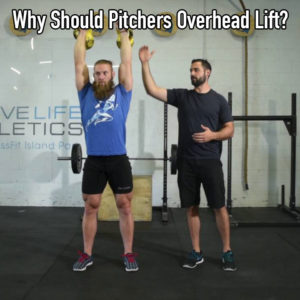 It has been the conventional wisdom for years to NOT let pitchers lift overhead due to arm injury. The theory is if pitchers lift overhead then they will fatigue their arm for throwing or they will injure it from the stress of the lift. This "old school" mentality has been purely built on anecdotal evidence.
It has been the conventional wisdom for years to NOT let pitchers lift overhead due to arm injury. The theory is if pitchers lift overhead then they will fatigue their arm for throwing or they will injure it from the stress of the lift. This "old school" mentality has been purely built on anecdotal evidence.
I remember trying to overhead lift at 18 during the season when I didn't do it at all in the off-season. I felt pinching in my shoulders and serious soreness and fatigue in my arm. When all you know is pitching, the last thing you want to feel is soreness or fatigue in your arm. This forced me to follow the conventional wisdom and not lift and just throw. The problem was I tore my rotator cuff at 18 years old and I truly believe it was due to not understanding how to strengthen my arm/body while throwing.
In this article, I will use the latest science to prove why should pitchers lift overhead. I will also define how it saved Kris Medlen's professional career. You can also follow ActiveLifeRX to learn more about building overhead strength.
The Reasons Pitchers Lift Overhead
Unfortunately, it isn't enough to just throw or pitch to strengthen the arm.
Pitchers displayed weakness in three of four tests by comparison with controls, suggesting that the demands of pitching are insufficient to produce eccentric strength gains and may in fact lead to weakness (Magnusson, Gleim & Nicholas, 1994)
This weakness following a season becomes a serious problem for pitchers who do not take off-seasons to develop enough shoulder strength for them to handle the next full season. Unfortunately, going into pre-season without strengthening the upper body is a receipt for disaster.
Preseason weakness of external rotation and supraspinatus strength is associated with in-season throwing-related injury resulting in surgical intervention in professional baseball pitchers (Byram et al., 2010).
The conventional wisdom does attempt to develop this strength with light dumb work or light resistance tubing in-season but I find this low load high volume training not as effective in developing overhead shoulder strength that emulates the eccentric forces hitting the arm at 90 degrees of abduction following pitch release.
In the study by Fleisig, Bolt, Fortenbaugh, Wilk, and Andrews (2011) seventeen college pitchers throwing 83mph on average, on a mound sixty fee six inches from target, had a shoulder proximal force at ball release of 1172 Newtons which equals 263 lbs of linear force. I find it hard to believe a 10-20 lb piece of tubing or a 3-5 lb dumbbell can build enough posterior shoulder strength to resist the distraction forces of a 90mph fastball.
This is why MLB Pitcher Kris Medlen, who came to train with me to rebuild his career following two Tommy John Surgery and most recent rotator cuff inflammation, said the overhead lifting helped stabilize his joints which allowed him to pitch his first complete season as a starter in 4 years. He had a total of 110 innings pitch 2017 injury free. See testimonial below.
My Experience When Pitchers Lift Overhead
In my practice, I have found success in programming a good amount of heavy loading overhead through the offseason coupled with low stress throwing drill training to prevent falling into arm fatigue. If enough overhead strength is built during off-season, it will be easier to keep adequate overhead strength through the season. A lower load and volume overhead lifting program will still be used to maintain strength in-season.
If baseball doesn't use the evidence in research today to meet the demands science is advising to reverse the skyrocketing injury rate then we will continue to see great careers like Kris Medlen cut short. I hope baseball is listening!
Reference:
- Louis U. Bigliani,* MD, Timothy P. Codd, MD, Patrick M. Connor, MD, William N. Levine, MD, Mark A. Littlefield, AT,C, and Stuart J. Hershon, MD. Shoulder Motion and Laxity in the Professional Baseball Player. From The Shoulder Service, New York Orthopaedic Hospital, Columbia-Presbyterian Medical Center, New York, New York
- S. Peter Magnusson, Gilbert W. Gleam, and James A Nicholas. Shoulder weakness in professional baseball pitchers. MISMAT, Lennox Hill Hospital, New York, NY 10021
- Ian R. Byram, MD, Brandon D. Bushnell, MD, Keith Dugger, ATC, Kevin Charron, MD, Frank E. Harrell Jr, PhD, and Thomas J. Noonan, MD. Preseason Shoulder Strength Measurements in Professional Baseball Pitchers Identifying Players at Risk for Injury. From the Department of Orthopaedic Surgery, Vanderbilt University, Nashville, Tennessee, Harbin Clinic Orthopaedics and Sports Medicine, Rome Braves Baseball Club, Rome, Georgia, Colorado Rockies Baseball Club, Denver, Colorado, Carrollton Orthopaedic Clinic, Carrollton, Georgia, the Department of Biostatistics, Vanderbilt University, Nashville, Tennessee, and Steadman-Hawkins Clinic Denver, Greenwood Village, Colorado
- GLENN S. FLEISIG, PhD, BECKY BOLT, MS, DAVE FORTENBAUGH, MS, KEVIN E. WILK, DPT, JAMES R. ANDREWS, MD. Biomechanical Comparison of Baseball Pitching and Long-Toss: Implications for Training and Rehabilitation. journal of orthopaedic & sports physical therapy



